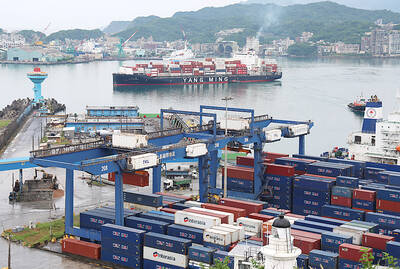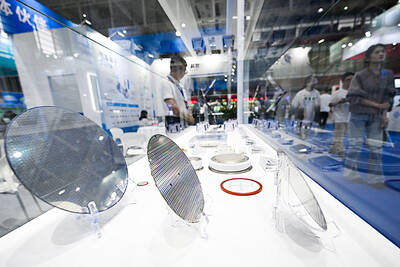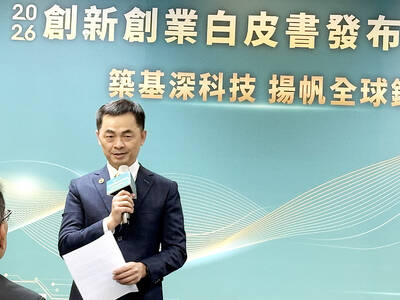United Renewable Energy Co (URE, 聯合再生能源), the nation’s biggest supplier of solar cells and modules, yesterday gave a positive outlook for the second half of this year after losses narrowed last quarter, thanks to price increases and a better product portfolio.
URE’s loss during the April-to-June period improved to NT$225 million, compared with a net loss of NT$530 million in the first quarter and NT$641 million in the second quarter of last year, the company said.
The company said in a statement that it posted monthly profits last quarter as strong demand boosted average selling prices and raw material costs stabilized.
“The company is seeing strong demand from the Taiwanese market. It has received solar module orders for shipments next year and the year after,” URE said in the statement. “As the average selling price is stabilizing, URE expects profits to improve in the second half of this year.”
The company expects a new wave of solar system installation demand in the third and fourth quarters of this year, as only a small share, or 420 megawatts of solar systems, out of a total 2.5 gigawatts were installed in the first half of this year.
Benefiting from the surge in domestic demand, URE expects shipments to grow significantly, the statement said.
The company’s board of directors yesterday approved a NT$433 million (US$15.56 million) capacity expansion plan to build a new production line for the manufacturing of advanced solar cells, it said in a filing with the Taiwan Stock Exchange.
Installed solar cell capacity would be as high as 500 megawatts a year, it said.
The new investment aims to cope with rising demand for high-efficiency solar cells, it added.
URE also saw improvement in costs after silicon wafer suppliers announced price cuts, boding well for the company’s profitability for the rest of the year.
It generated gross profit of NT$270 million during last quarter, reversing a gross loss of NT$47 million in the first quarter of this year and a gross loss of US$157 million in the second quarter of last year.

Taiwan’s exports soared 56 percent year-on-year to an all-time high of US$64.05 billion last month, propelled by surging global demand for artificial intelligence (AI), high-performance computing and cloud service infrastructure, the Ministry of Finance said yesterday. Department of Statistics Director-General Beatrice Tsai (蔡美娜) called the figure an unexpected upside surprise, citing a wave of technology orders from overseas customers alongside the usual year-end shopping season for technology products. Growth is likely to remain strong this month, she said, projecting a 40 percent to 45 percent expansion on an annual basis. The outperformance could prompt the Directorate-General of Budget, Accounting and

Two Chinese chipmakers are attracting strong retail investor demand, buoyed by industry peer Moore Threads Technology Co’s (摩爾線程) stellar debut. The retail portion of MetaX Integrated Circuits (Shanghai) Co’s (上海沐曦) upcoming initial public offering (IPO) was 2,986 times oversubscribed on Friday, according to a filing. Meanwhile, Beijing Onmicro Electronics Co (北京昂瑞微), which makes radio frequency chips, was 2,899 times oversubscribed on Friday, its filing showed. The bids coincided with Moore Threads’ trading debut, which surged 425 percent on Friday after raising 8 billion yuan (US$1.13 billion) on bets that the company could emerge as a viable local competitor to Nvidia

BARRIERS: Gudeng’s chairman said it was unlikely that the US could replicate Taiwan’s science parks in Arizona, given its strict immigration policies and cultural differences Gudeng Precision Industrial Co (家登), which supplies wafer pods to the world’s major semiconductor firms, yesterday said it is in no rush to set up production in the US due to high costs. The company supplies its customers through a warehouse in Arizona jointly operated by TSS Holdings Ltd (德鑫控股), a joint holding of Gudeng and 17 Taiwanese firms in the semiconductor supply chain, including specialty plastic compounds producer Nytex Composites Co (耐特) and automated material handling system supplier Symtek Automation Asia Co (迅得). While the company has long been exploring the feasibility of setting up production in the US to address

OPTION: Uber said it could provide higher pay for batch trips, if incentives for batching is not removed entirely, as the latter would force it to pass on the costs to consumers Uber Technologies Inc yesterday warned that proposed restrictions on batching orders and minimum wages could prompt a NT$20 delivery fee increase in Taiwan, as lower efficiency would drive up costs. Uber CEO Dara Khosrowshahi made the remarks yesterday during his visit to Taiwan. He is on a multileg trip to the region, which includes stops in South Korea and Japan. His visit coincided the release last month of the Ministry of Labor’s draft bill on the delivery sector, which aims to safeguard delivery workers’ rights and improve their welfare. The ministry set the minimum pay for local food delivery drivers at